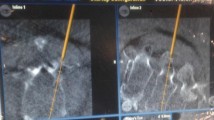Abstract
Purpose
Lumbar fusion using lateral single position surgery (LSPS) gained popularity during the last few years. While prone percutaneous pedicle screw placement is well described, placing percutaneous pedicle screws with the patient in the lateral position is considered the most complicated part of LSPS. In this article we describe the fluoroscopy navigated technique for lateral percutaneous screw placement using the tunnel view technique.
Methods
The radiologic background and principles of the tunnel view technique are described. In addition, the special positioning of the patient, the C-arm and the surgical technique is discussed in detail.
Results
This technique is used as the standard for percutaneous screw placement in the prone or lateral positions in our department since 2017. Since the introduction of this technique we have had 0% reoperation rate for symptomatic malpositioned pedicle screws.
Conclusion
The tunnel view technique simplifies pedicle screw placement while allowing for permanent observation of pedicle walls and the superior joint surface during placement of the Jamshidi needle. It also allows for confirmation of intrapedicular position of the screw after its implantation. This technique is safe and feasible in our clinical experience.









Similar content being viewed by others
References
Drazin D, Kim TT, Johnson JP (2015) Simultaneous lateral interbody fusion and posterior percutaneous instrumentation: early experience and technical considerations. Biomed Res Int 2015:458284. https://doi.org/10.1155/2015/458284
Malham GM, Wagner TP, Claydon MH (2019) Anterior lumbar interbody fusion in a lateral decubitus position: technique and outcomes in obese patients. Journal of spine surgery (Hong Kong) 5(4):433–442
Thomas JA, Thomason C, Braly BA, Menezes CM (2020) Rate of failure of indirect decompression in lateral single-position surgery: clinical results. Neurosurg Focus 49(3):E5. https://doi.org/10.3171/2020.6.FOCUS20375
Magerl FP (1984) Stabilization of the lower thoracic and lumbar spine with external skeletal fixation. Clin Orthop Relat Res 189:125–141
Wiesner L, Kothe R, Rüther W (1999) Anatomic evaluation of two different techniques for the percutaneous insertion of pedicle screws in the lumbar spine. Spine 24(15):1599–1603. https://doi.org/10.1097/00007632-199908010-00015
Anderson DG (2014) Nuances of percutaneous thoracolumbar pedicle screw fixation (Page 100) in MY Wang et al. (eds.) Minimally Invasive Spinal Deformity Surgery. Springer-Verlag Wien
Charles YP, Ntilikina Y, Collinet A, Schuller S, Garnon J, Godet J, Clavert P (2021) Accuracy and technical limits of percutaneous pedicle screw placement in the thoracolumbar spine. Surgical and radiologic anatomy: SRA 43(6):843–853. https://doi.org/10.1007/s00276-020-02673-7
Ohba T, Ebata S, Fujita K, Sato H, Haro H (2016) Percutaneous pedicle screw placements: accuracy and rates of cranial facet joint violation using conventional fluoroscopy compared with intraoperative three-dimensional computed tomography computer navigation. Eur Spine J 25(6):1775–1780. https://doi.org/10.1007/s00586-016-4489-1
Babu R, Park JG, Mehta AI, Shan T, Grossi PM, Brown CR, Richardson WJ, Isaacs RE, Bagley CA, Kuchibhatla M, Gottfried ON (2012) Comparison of superior-level facet joint violations during open and percutaneous pedicle screw placement. Neurosurgery 71(5):962–970. https://doi.org/10.1227/NEU.0b013e31826a88c8
Agnes R (2020) Stogicza et al. (eds.) Interventional pain, Springer
Manchikanti L (2007) Vijay Singh: Interventional techniques in chronic spinal pain,
Bodon G, Kiraly K, Baksa G, Barany L, Kiss M, Hirt B, Pussert A, Timothy J, Stubbs L, Khajavi K, Braly B (2021) Applied anatomy and surgical technique of the lateral single-position L5–S1 fusion. Clinical Anatomy (New York, N.Y) 34(5):774–784. https://doi.org/10.1002/ca.23733
Gertzbein SD, Robbins SE (1990) Accuracy of pedicular screw placement in vivo. Spine 15(1):11–14. https://doi.org/10.1097/00007632-199001000-00004
Blizzard DJ, Thomas JA (2018) MIS single-position lateral and oblique lateral lumbar interbody fusion and bilateral pedicle screw fixation: feasibility and perioperative results. Spine 43(6):440–446. https://doi.org/10.1097/BRS.0000000000002330
Ziino C, Arzeno A, Cheng I (2019) Analysis of single-position for revision surgery using lateral interbody fusion and pedicle screw fixation: feasibility and perioperative results. Journal of spine surgery (Hong Kong) 5(2):201–206
Hiyama A, Katoh H, Sakai D, Sato M, Tanaka M, Watanabe M (2019) Comparison of radiological changes after single- position versus dual- position for lateral interbody fusion and pedicle screw fixation. BMC Musculoskelet Disord 20(1):601. https://doi.org/10.1186/s12891-019-2992-3
Sellin JN, Brusko GD, Levi AD (2019) Lateral lumbar interbody fusion revisited: complication avoidance and outcomes with the mini-open approach. World Neurosurg 121:e647–e653. https://doi.org/10.1016/j.wneu.2018.09.180
Acknowledgements
I would like to use this opportunity to thank Prof. Dr. Juergen Degreif for his continuous support during the past eleven years. I learned surgical decision making from him, for which I will always be grateful. I wish him good health and joy for the coming years after his retirement.
Author information
Authors and Affiliations
Corresponding author
Ethics declarations
Conflict of interest
None.
Additional information
Publisher's Note
Springer Nature remains neutral with regard to jurisdictional claims in published maps and institutional affiliations.
Rights and permissions
About this article
Cite this article
Bodon, G., Degreif, J. Fluoroscopy-based percutaneous posterior screw placement in the lateral position using the tunnel view technique: technical note. Eur Spine J 31, 2204–2211 (2022). https://doi.org/10.1007/s00586-022-07126-w
Received:
Revised:
Accepted:
Published:
Issue Date:
DOI: https://doi.org/10.1007/s00586-022-07126-w




